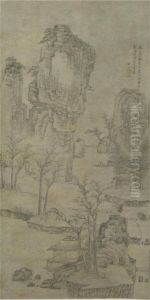Hong Ren Paintings
Hong Ren, also known by his monastic name Monk Baozhu, was a Chinese painter during the early Qing Dynasty, which followed the collapse of the Ming Dynasty. He was born in 1610 in Anhui Province, which was part of the region historically known for the Anhui or Xin'an school of painting, a style that emphasized simplicity and elegance. Hong Ren was one of the 'Four Monks,' a group of Buddhist monk painters who renounced worldly life and expressed their spirituality through art. The other three monks were Zhu Da, Shitao, and Kun Can, all of whom were notable painters of that period.
Hong Ren became a monk following the fall of the Ming Dynasty and the establishment of the Qing Dynasty in 1644. This transition was a traumatic time for many Chinese scholars and officials who had been loyal to the Ming. As a monk, Hong Ren dedicated himself to a life of Buddhist practice and contemplation, which deeply influenced his approach to painting. His works are characterized by their austere and refined style, utilizing minimalistic brushwork and subdued colors to create landscapes that express a sense of tranquility and other-worldliness. His paintings often reflect the inner peace and detachment from the material world that he sought through his Buddhist faith.
Despite his reclusive life, Hong Ren's paintings were highly regarded, and he had a significant influence on the development of later Chinese landscape painting. His style was marked by a distinctive use of brushwork - with dry, disciplined strokes that often left much of the canvas empty, embodying the concept of 'liubai' or 'leaving blank.' Hong Ren's landscapes typically feature towering mountain peaks and slender trees, with human figures and the built environment reduced to the most minimal presence, if included at all. His work is seen as a reflection of his personal journey towards spiritual enlightenment, and his legacy endures as a major figure in Chinese art history. Hong Ren died in 1663, leaving behind a body of work that continues to be celebrated for its purity, quietude, and depth.





